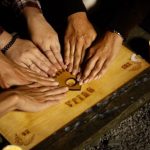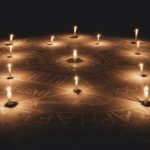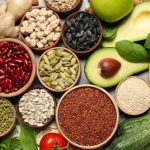 Our World
Our World  Our World
Our World  Movies and TV
Movies and TV The 10 Coolest Stars to Set Sail on The Love Boat
 History
History 10 Things You Didn’t Know About the American National Anthem
 Technology
Technology Top 10 Everyday Tech Buzzwords That Hide a Darker Past
 Humans
Humans 10 Everyday Human Behaviors That Are Actually Survival Instincts
 Animals
Animals 10 Animals That Humiliated and Harmed Historical Leaders
 History
History 10 Most Influential Protests in Modern History
 Creepy
Creepy 10 More Representations of Death from Myth, Legend, and Folktale
 Technology
Technology 10 Scientific Breakthroughs of 2025 That’ll Change Everything
 Our World
Our World 10 Ways Icelandic Culture Makes Other Countries Look Boring
 Our World
Our World 10 Ways Your Christmas Tree Is More Lit Than You Think
 Movies and TV
Movies and TV The 10 Coolest Stars to Set Sail on The Love Boat
 History
History 10 Things You Didn’t Know About the American National Anthem
Who's Behind Listverse?

Jamie Frater
Head Editor
Jamie founded Listverse due to an insatiable desire to share fascinating, obscure, and bizarre facts. He has been a guest speaker on numerous national radio and television stations and is a five time published author.
More About Us Technology
Technology Top 10 Everyday Tech Buzzwords That Hide a Darker Past
 Humans
Humans 10 Everyday Human Behaviors That Are Actually Survival Instincts
 Animals
Animals 10 Animals That Humiliated and Harmed Historical Leaders
 History
History 10 Most Influential Protests in Modern History
 Creepy
Creepy 10 More Representations of Death from Myth, Legend, and Folktale
 Technology
Technology 10 Scientific Breakthroughs of 2025 That’ll Change Everything
 Our World
Our World 10 Ways Icelandic Culture Makes Other Countries Look Boring
10 Foods That Have Alleged Occult Powers
Do you want to know what the future holds for you? It appears you don’t have to look any further than your kitchen for guidance. Before astrology apps and online psychics were available, people turned to the most basic commodity they had available: food. Almost everyone is familiar with fortune-telling with tea leaves and coffee grounds, but other common foodstuffs have been used for soothsaying.
Kitchen divination, as it is called, has been eclipsed in modern times by tarot readings, horoscopes, and crystal balls. However, it is now seeing a resurgence spurred by a renewed interest in paganism. Internet sites now offer courses on the fundamentals of food divination for those willing to try.
Related: 10 Royals Who Dabbled in the Occult
10 Flour
Divination using flour is called aleuromancy, “aleuron” being Greek for flour. It was recorded in cuneiform tablets as early as the second millennium BC and involved predicting the future based on the shapes of small heaps of flour. In ancient Greece, it was a communal practice believed to be presided over by the god Apollo, who was surnamed Aleuromantis.
Greeks would write symbols or messages on pieces of cloth or papyrus and insert these into pieces of dough, which were then baked into cakes. The cakes were mixed up nine times before being distributed, and recipients would consult a priest or diviner to interpret the particular symbol or message embedded in their bread that revealed their future. The modern fortune cookie, actually a 20th-century invention by Chinese immigrants in the U.S., is a form of this divinatory technique.
Variations of this method involve throwing flour on the ground and interpreting the shapes produced or mixing flour and water in a bowl, pouring it out, and reading the patterns left by the flour in the bowl.[1]
9 Salt
Modern superstitions like spilling salt being bad luck or throwing salt over someone’s shoulder for good fortune are survivals of alomancy, the ancient art of divination using salt. We know salt is a preservative, and in many parts of the world, salt was believed to contain magical power and thus used for rituals of purification, protection, and blessing. Ancient magicians put a pinch of salt in each corner of a room before casting a spell or performing a ritual.
In Egypt, salt was thrown into the air, and the patterns it made as it fell to the ground were interpreted for meaning. Greeks and Romans mixed salt with the cakes they offered to the gods. The residue left in a bowl by a salt solution was also read for hidden messages. Salt tossed into the fire was also a source of occult revelation.
Another contemporary method used by modern witches is to pour salt into a square or rectangular pan to a depth of three inches. A pencil is held loosely over the center while a question is asked. The pencil is supposed to move on its own to trace figures on the bed of salt. Commonly, a “Y” means yes, “N” means no, and “P” is perhaps. A long line symbolizes a journey, a short line for a visitor. A large circle bodes misfortune, a triangle success. A square means obstacles, a heart symbolizes love, and a broken heart is for separation.[2]
8 Barley Bread
An ancient form of the lie detector test was alphitomancy, divination using barley bread. In this method, suspects in a crime were fed a loaf of barley to determine the guilty party. The culprit was supposed to suffer an attack of indigestion. The oath “If I am deceiving you, may this piece of bread choke me” stemmed from this practice.
Not only criminals but also unfaithful lovers and husbands were exposed by the barley bread test. Pure barley flour was kneaded with milk and a little salt and left unleavened. The mixture was rolled in grease, baked, and rubbed with verbena leaves. It was given to the accused cheater to eat, and guilt was proven if he could not digest it.
There was said to be a sacred forest in Lavinium near ancient Rome where young girls were sent blindfolded and bearing barley cakes in a ritual to test their purity. The priests, legend goes, kept a serpent or a dragon in a cave in the woods. The barley cakes were given to the serpent, who ate those belonging to pure virgins and refused those from the less than chaste.[3]
7 Cheese
The process of cheese-making, in which liquid milk turns solid, has long fascinated people. It seems magical, and 12th-century mystic Hildegard von Bingen described it as “the miracle of life.” Since ancient times, milk has been linked to love, spirituality, sustenance, and nurturing, so by extension, cheese has associations with the Moon, grounding, health, joy, and fruition. Ancient Sumerians gave cheese offerings to the goddess Inanna, and cheese was used for centuries in spell casting.
Tyromancy, divination with cheese, was first recorded by 2nd-century Greek historian and diviner Artemidorus of Ephesus, who complained that cheese diviners were con artists who gave genuine diviners like him a bad name and threatened their livelihood. But because cheese was handy and readily available, it was a popular method of fortune-telling among common rural folk, reaching a peak in the Middle Ages and the early modern period.
Medieval diviners studied cheese for its shape, number of holes, patterns of mold, and other peculiar characteristics to get a reading. An odd number of holes, for example, bode misfortune. Young girls traditionally carved the names of their crushes or potential suitors onto pieces of cheese. The first to grow mold would yield the name of their perfect match.
Cheese reading waned in the 1920s in favor of tarot cards, but interest in occult circles has been renewed of late by the video game series The Witcher and Baldur’s Gate.[4]
6 Fruits
Many cultures have regarded different fruits as meaningful symbols. An apple, for example, is associated with health, wisdom, and knowledge. A lemon is suggestive of cleansing and purification. The appearance and characteristics of fruits—size, shape, color, texture, blemishes, and imperfections—can reveal a wealth of information to practitioners of fructomancy, the art of fruit divination. Diviners also interpret the way a fruit feels and smells. Shearing one long ribbon of apple or orange peel, then tossing it and reading the shape it makes as it lands is another method. The fruit can also be cut open, and the seeds can be examined for additional messages.
A popular Halloween party game in Britain is writing down the name of each guest on an apple and then throwing all apples thus inscribed into a tub of water. Partygoers dive their heads into the water and attempt to capture a floating apple with their mouths. The name on the fruit will be that of their future spouse.
One televised fruit oracle occurred in 2018, when Holly Willoughby, host of British talk show This Morning, sliced a “psychic banana” to predict the gender of Prince William’s and Princess Kate’s anticipated third child. Would it be a baby boy? Cutting off the tip, viewers could plainly see a Y-shape in the center of the fruit’s cross-section, which means “Yes.” A dot would have meant no.
Prince Louis of Cambridge was born a short while later.[5]
5 Onions
Onions, with their pungent odor that either repels or attracts, depending on who you ask, have a long history of occult associations. In ancient Egypt, they were believed to drive evil spirits away. Even today, people stick pins into onions and put them on the windowsill to keep out malignant spirits. Placing an onion under your pillow while you sleep is said to reveal your future partner through your dreams.
Cromniomancy, or divination with onions, was especially popular in medieval Europe. The color, smell, direction, and form of onion sprouts were considered significant indicators of the future. Possible answers to questions or wishes were placed in onions, which were then buried in the ground. The answer contained in the onion that sprouted first portended the future. Some believed burning onion skins in the fire would make a wish come true. Similarly, unmarried girls would carve the names of suitors on onions and place them by the fire on December 1. The name on the onion that sprouted first would be “The One.”
In the town of Urbania, Italy, onions are still used to predict the weather, a carry-over from the time before there were weather forecasts in the news, back to the Middle Ages. Every January 25, a local diviner slices a yellow onion into 12 pieces, one for each month of the year. She lays them out and sprinkles salt over them, then leaves them out overnight facing east. The next morning, she notes how the salt reacted with the onion and makes her prognostications from them.[6]
4 Corn
To the ancient inhabitants of Mesoamerica, life revolved around corn or maize. It was not just their staple food; it was the link between the human and the divine. The Popol Vuh, the Mayan creation story, relates how the gods formed humanity out of yellow and white corn. In Mexico, maize was a gift from the god Quetzalcoatl. It was, therefore, quite logical for these people to regard corn as a means to divine the future.
Dozens of corn divination techniques were practiced in ancient Mexico and are still in use by indigenous people today. As with most divinatory methods, these involve, with certain variations, casting corn kernels abroad and reading the resulting patterns. Anywhere between four and 100 grains, sometimes of different colors, may be cast. Some throw them onto a white canvas; others in a basin of water when a reading depends on whether they float or sink.
Corn was introduced to Europe in the 15th century and has since been used in Halloween fortune-telling. Scottish poet Robert Burns writes of one such method: “You go to the barn, and open both doors, taking them off the hinges, if possible; for there is danger that the being about to appear may shut the doors, and do you some mischief. Then take that instrument used in winnowing the corn (grain), which in our country dialect we call a ‘wecht,’ and go through all the attitudes of letting down corn against the wind. Repeat it three times, and the third time, an apparition will pass through the barn, in at the windy door and out at the other, having both the figure in question and the appearance or retinue, marking the employment or station in life, of your future spouse.”[7]
3 Eggs
Easter eggs are a reminder that for most of history, many cultures have imbued the humble egg with mystical and religious significance. For obvious reasons, it is symbolic of life, rebirth, the soul, and fertility. Ancient creation myths from Greece to China all tell of the birth of the universe from a cosmic egg.
Eggs were considered magical and used in spells for good fortune, love, protection, and transformation. Druids had egg amulets believed to contain healing powers. Ovomancy refers to oracle reading using eggs. Among the various methods is to pour egg white into slightly boiling water and interpret the shapes it forms. Another is to crack a hard-boiled egg and read the lines formed on the shell. Divine answers can also be gleaned in the shapes made by the shell, white, and yolk when the egg is dashed on the ground or in a dish.
One can also perform a spiritual cleansing using eggs. A raw egg is rolled over a person’s body, and it absorbs all the negative energy. The egg is then cracked open and examined for tell-tale signs—webbing, blood, black spots—that may indicate the person’s ailment. The egg is then disposed of at a crossroads.
The Salem Witch Trials of 1692–93 were sparked by an egg. Young girls in the strict Puritan household of the Reverend Samuel Parrish, which included his daughter and niece, had been playing a game where they dropped an egg into a glass of water. The pattern formed by the egg white was supposed to reveal their future husbands and what life had in store for them. Instead, the girls thought they saw a coffin and began barking and crying hysterically. The town believed the girls had allowed the devil in and were now possessed.
Things escalated from there, and when the frenzy and trials died down, 19 people were hanged, and one was crushed to death by heavy stones.[8]
2 Wine
In ancient Greece and Rome, wine was poured out as libation to the gods. The Greek god of wine, Dionysus, was believed to bestow inspiration and foreknowledge. In a game called “kottabos,” contestants would fling wine from their cups toward a bronze disk target balanced on top of a pole in an attempt to make it fall. The patterns created by the wine thus spilled were sometimes interpreted for messages, like inkblots.
In Rome, the wine god Bacchus had a priestess called Bacchante who performed wine oracles. Called oinomancy, wine divination came in several forms. Aside from pattern reading, the sediment of dregs left by wine in cups or casks was examined. Its color, taste, and other peculiarities were also taken into account.
Wine might also be poured into a glass vessel and a lamp lit behind it. The diviner asked questions and gazed into the liquid in search of answers formed by the wine’s reflection.
Wine reading is less widely practiced today in favor of cheaper fortune-telling methods like tarot and horoscopes. It is still done, however, in more exclusive circles.[9]
1 Beans
A popular form of fortune-telling in the Balkans and Russia, favomancy, or divination with beans, may have originated in the Middle East, possibly Iran. A story is told that the prophet Muhammad’s daughter Fatima secretly divined with beans. One day, Muhammad suddenly caught her in the act of reading for a friend. The panicked girl managed to hide half of the beans under her dress. From this incident stemmed the belief that every oracle consisted of half-truths and half-lies, which a skeptic might point out is a convenient cover for failed predictions.
Bean divination typically involves scattering them and looking for patterns they form. In Bosnia, the diviner uses 41 beans in a ritual called “bacanje graha” (bean throwing). Verses from the Quran are recited over the beans, which are then thrown three times, each representing the past, present, and future.
Favomancy was also practiced in Renaissance Italy, and many women were tried by the Inquisition for tossing beans, which the Church condemned as a summon to demons to predict the future.[10]








